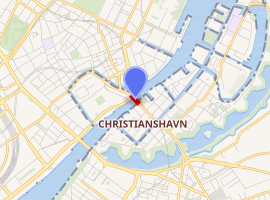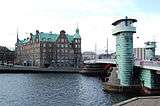Knippelsbro
Knippelsbro (English: Knippel Bridge) is a bascule bridge across the Inner Harbour of Copenhagen, Denmark, connecting Børsgade (English: Stock Exchange Street) on Zealand-side Slotsholmen to Torvegade (English: Market Street) on Christianshavn. It is one of only two bridges to carry motor vehicles across the harbour in central Copenhagen, the other being Langebro.
Knippelsbro | |
|---|---|
.jpg) | |
| Coordinates | 55°40′29″N 12°35′14″E |
| Carries | Motor vehicles, pedestrian and bicycle traffic |
| Crosses | Copenhagen Inner Harbour |
| Locale | Slotsholmen Christianshavn |
| Characteristics | |
| Design | Bascule bridge |
| Total length | 115 m |
| Width | 27 m |
| Clearance below | 52 ft (16 m) |
| History | |
| Designer | Kaj Gottlob |
| Opened | December 17, 1937 |

| |
The bridge, the fifth on the site, is 115 metres long and was inaugurated in 1937.
History
1620: The first bridge

The first bridge between Copenhagen and Christianshavn was constructed in 1618-20 by Christian IV in connection with the foundation of Christianshavn. The bridge was called the "Great Amager Bridge" or "the long bridge".[1]
1712: The second bridge
A new wooden bridge was built in the same location in 1712. It was decorated with four Hercules sculptures by the artist Johan Christopher Sturmberg. Neither the sculptures or images of them exist today.
1816:The third bridge
The bridge was replaced by a new, wooden bridge in 1816. The bridge had two gates which were decorated with four wooden sculptures of "The Four Winds". They were created by the sculptor Frederik Christian Willerup and are now owned by the Museum of Copenhagen.
1869: The B&W bridge
In 1868-69, Burmeister & Wain constructed a railway bridge based on renderings from the grocers J. Adolphs and Christian August Broberg. It ran from Slotsholmsgade to Torvegade and it was therefore possible to use the old bridge while it was built. It opened on 1 August 1869.
1908: Axel Berg's bridge
.jpg)
A new railway bridge was built in 1908. It was designed by the architect Axel Berg and had two characteristic pavilions. It was built by the Port Authority's building master H. C. V. Møller and opened on 30 December 1908. It ran from Børsgade to Torvegade.
1937: The current bridge
In the first half of the 1930s, it was once again decided to build a new bridge. It was decided to build it at the same site as the old one and it was therefore necessary to build a temporary bridge. It was in use from 1934 to 1937.
The current Knippelsbro was inaugurated on 17 December 1947. It was designed by Kaj Gottlob and built by Wright, Thomsen & Kier in collaboration with Burmeister & Wain.
Name
The bridge was originally known as Store Amager Bro (English: Great Amager Bridge) or Langebro (English: Long Bridge) and from around 1700 Christianshavns Bro (English: Christianshavn's Bridge) is seen.[2] The current name stems from Hans Knip who became bridge caretaker in 1641, in charge of operating the bridge and collecting tolls from passing ships. His house became known as Knippenshus and during the 17th century the bridge became known as Knippensbro. The current form of the name is seen from the second half of the 19th century but has never been officially approved.[3]
Cultura references
- The Olsen-banden steals the priceless Bedford Diamonds from a car on Knippel Bridge at 0:57:54 in The Last Exploits of the Olsen Gang..[4]
- A view of Knippel Bridge from Hotel Europa (now DanHostel Copenhagen City) is also seen at 1:07:19 in The Olsen Gang on the Track.[5]
Gallery
 View along the bridge from Christianshavn
View along the bridge from Christianshavn One of the control towers
One of the control towers
References
- "Broerne i Københavns Havn fredes". Bygningskultur Christianshavns Lokalhistoriske Forening og Arkiv. Retrieved 2 February 2017.
- "Knippelsbro, Knippelsbrogade". Absalon. Retrieved 2009-07-23.
- "Knippelsbro, Knippelsbrogade". Absalon. Retrieved 2009-07-23.
- "Film 6 Olsen Bandens sidste bedrifter / Der (voraussichtlich) letzte Streich der Olsenbande". olsenbande-homepage.de (in German). Retrieved 5 October 2017.
- "Film 7 Olsen banden på sporet / Die Olsenbande stellt die Weichen". olsenbande-homepage.de (in German). Retrieved 5 October 2017.
External links
| Wikimedia Commons has media related to Knippelsbro. |
- Listing by the Danish Heritage Agency
- G. Lorenz. "Ny Knippelsbro", page B1-B18 (13-30). Ingeniøren, 8 January 1938.